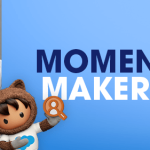Understanding Customer Experience Automation (CXA)



Unlock the realm of Customer Experience Automation with our insightful guide. Delve into the transformative power of Salesforce tools, demystifying how automation enhances customer interactions, fosters loyalty, and elevates your brand. Gain a deeper understanding of CX automation for a future-ready business strategy.
To gain insight into the realm of Customer Experience Automation (CXA) and its potential to shape customer expectations and enhance overall satisfaction, it’s essential to explore how businesses employ automation to streamline repetitive, manual tasks, mitigating the risk of human error. This is particularly vital in improving client contentment.
Customer Experience Automation, or CXA, leverages automation tools like AI chatbots and automated email campaigns to elevate the quality of customer interactions. CXA solutions optimise communication with both prospective and existing customers, ensuring their needs are met seamlessly from start to finish, resulting in more personalised interactions. The advantages of automating the customer experience are diverse and manifold.
Furthermore, CX automation is gaining increasing popularity in the business landscape. If you’re ready to embark on your CXA journey, continue reading to delve into the world of customer experience automation. Learn how it distinguishes itself from marketing automation, understand its benefits, and discover its myriad applications within your organisation.
Defining Customer Experience Automation
CX automation empowers businesses to automate individualised customer engagement throughout the entire customer lifecycle, expediting communication and personalisation. Instead of relying on service representatives for daily client interactions, automation solutions shoulder much of this workload, thereby minimising human intervention and streamlining operations.
For successful customer experience automation, it is imperative to incorporate the following elements:
- Orchestration: Utilising existing customer data to pinpoint areas where automation can be most effective, you can set up your touchpoints and communicate with clients at opportune moments.
- Segmentation: By categorising your audience into subgroups based on shared characteristics like demographics, shopping habits, and personal values, segmentation ensures that each contact receives content tailored to their unique requirements and at the most appropriate times.
- Personalisation: Personalisation guarantees that every interaction with your brand is tailored to the individual, enabled by the data collected during segmentation efforts.
- Automation: The ability to analyse customer data and harness it to automate communication processes.
Recognising that customer experience and customer service have distinct meanings is essential. While customer service represents a single instance of support when a client requires assistance, customer experience encompasses every interaction with your business.
CX Automation vs. Customer Relationship Management (CRM)
While CXA focuses on automating the entire customer journey, Customer Relationship Management (CRM) involves organising and managing client relationships and analysing interaction-derived data. These two components work harmoniously to improve customer experience and cultivate more robust connections with your audience.
CRM software aggregates and evaluates automatically or manually collected information, providing a centralised dashboard for accessing client data, promoting interaction uniformity, and personalising customer engagement.
With CX automation, you can leverage the insights from your CRM to automate specific interactions throughout the customer journey.
CX Automation vs. Marketing Automation
CXA tools are designed to guide customers through their journey from start to finish and beyond, ensuring comprehensive care at all stages of the buying process. In contrast, marketing automation primarily concentrates on enhancing funnelling efforts to progress individuals through different stages and campaigns.
The Benefits of Customer Experience Automation
The advantages of utilising customer experience tools include improved customer communication, enhanced operational efficiency, and fortified customer relationships. Notable benefits include:
- 24/7 Support: Automation tools enable customers, both current and potential, to access support whenever they require it, even outside regular working hours. AI chatbots can address common issues without necessitating human intervention.
- Cost Reduction: Businesses can save money and minimise operational costs by automating various requests. This efficiency allows live agents to focus on more critical tasks.
- Enhanced Customer Satisfaction: Automation can reduce response times, provide high-quality support, and resolve issues more swiftly, increasing customer satisfaction and decreasing waiting times.
- Personalised Communications: Automation empowers businesses to offer personalised interactions, catering to individual needs and interests through product recommendations, targeted ads, and tailored emails.
- Consistency: CX automation minimises friction, ensuring that customers experience a consistent journey through the buying process and perceive your brand positively, while reducing the risk of unprofessional errors.
- Valuable Insights: CX automation software can gather crucial information about customer preferences and needs, enhancing your understanding of your clientele.
- Strengthened Customer Relationships: Automated customer experiences build stronger client connections, fostering loyalty and advocacy, ultimately contributing to increased sales and recommendations.
- Increased Profitability: A better customer experience, coupled with satisfied customers, can boost conversions and revenue, fostering business profitability. However, human interactions remain invaluable and sometimes indispensable.
Ways to Implement CX Automation
With predictions suggesting that 40% of customer interactions will be automated through AI and machine learning, the importance of CX automation is undeniable. Here are some practical ways to leverage CXA within your business to stay ahead of the competition:
- AI Chatbots: Deploy AI and machine learning-driven chatbots to respond swiftly to frequently asked questions, reducing customer wait times.
- Self-Service Scheduling: Streamline the appointment booking process with self-service tools, allowing customers to schedule appointments efficiently.
- Automated Emails: Employ various automated emails, such as abandoned cart notifications, new subscriber welcomes, and transactional messages, to enhance customer engagement.
- Live Chat: Offer real-time support through live chat solutions, ensuring customers receive timely assistance outside regular business hours.
- Feedback Surveys: Automate customer surveys to collect valuable feedback about their interactions with your brand, facilitating continuous improvement.
In conclusion, embracing CX automation enhances customer relationships and boosts sales and positions your business for success in a world where automation plays an increasingly significant role in customer interactions. While automation is invaluable, the human touch remains essential for certain interactions.




















